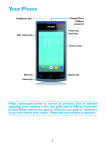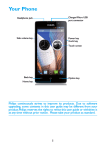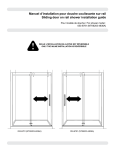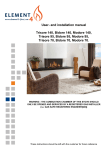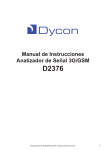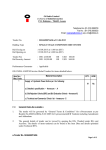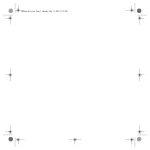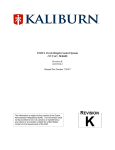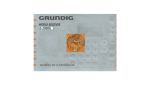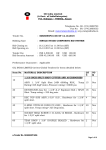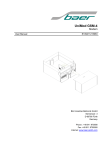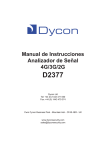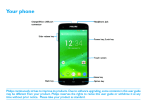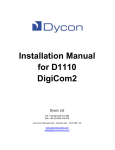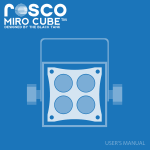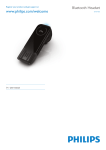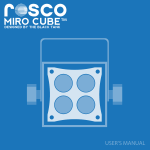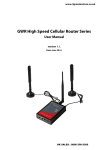Download D2376 3G Signal Anaylyser User Manual
Transcript
Operation Manual for the D2376 3G/GSM Signal Analyser www.3grouterstore.co.uk [email protected] Table Of Contents 1 DESCRIPTION.......................................................................................................................................3 2 3G/GSMSIGNALANALYSERCONTENTS................................................................................................3 3 QUICK START GUIDE ............................................................................................................................ 4 4 SITE SURVEY ........................................................................................................................................ 6 5 FITTING A SIM CARD ............................................................................................................................ 6 5.1 ENTERING THE SIM CARD’S PIN NUMBER ................................................................................................... 7 6 STARTUPSCREEN.................................................................................................................................8 7 MAINMENU........................................................................................................................................8 8 SETUP SCREEN ..................................................................................................................................... 9 9 OPTIONS............................................................................................................................................ 10 9.1 NETWORK OPTIONS .............................................................................................................................. 11 9.2 SELECT MODE...................................................................................................................................... 11 9.3 GPRS TEST ......................................................................................................................................... 12 10 SURVEY.............................................................................................................................................. 13 11 RESULTS ............................................................................................................................................ 14 12 MONITOR .......................................................................................................................................... 16 13 JAMMING DETECTION........................................................................................................................ 19 14 SCREENSAVER.................................................................................................................................... 19 15 POWER‐UP FUNCTIONS...................................................................................................................... 19 16 AERIAL SITING.................................................................................................................................... 20 17 BATTERY AND CHARGING .................................................................................................................. 20 18 APPENDIX 1 SPECIFICATION ............................................................................................................... 21 18.1 GSM FAULTS....................................................................................................................................... 21 19 APPENDIX 2 GLOSSARY OF TERMS...................................................................................................... 22 1 Description The D2376 is a signal analyser for use with GSM and 3G radio networks where automatic signalling equipment is used, including smart metering, 3G Routers and GSM Gateways. It may be used to position a GSM or 3G Antenna and to test the performance of aerial systems. The D2376 3G/GSM signal analyser displays mobile network information including; network provider names, cell identities, frequencies and signal strength. Jamming signals may also be detected. The D2376 3G/GSM signal analyser contains a battery allowing remote operation for up to 12 hours. The internal battery may be recharged from the supplied mains power supply or a suitable car charger. If the D2376 3G/GSM signal analyser is left switched on and unused, the unit will automatically switch off after a preset time. The D2376 3G/GSM signal analyser is contained within a strong protective sleeve and is supplied complete with a charger and manual. 2 3G/GSM Signal Analyser Contents Mains plug-top charger D2376 3G/GSM Signal Analyser 3 Quick Start Guide 1. Charge the battery before use Connect the aerial (see section 16). To switch on the signal analyser, press the On/Off button until the logo is shown .(1) 2. This is followed by the Startup screen (see section 6). This screen is shown for about 30 seconds while the radio module is powering up. 3. If a SIM is fitted that requires a PIN, this screen gives the option to use the Saved PIN or enter a new PIN (see section 5.1). If not, the Main Menu screen will appear. Once the Saved PIN is used or a new PIN is entered, the Main Menu screen will appear next. 4. MAIN Menu (See section 7 for information). Press the right button to select the Survey screen. 5. SURVEY Screen If Engineer mode is selected in Setup, the following screen will appear. If Surveyor mode is selected in Setup, the following screen will appear. (See section 10 for information) Press the right button to start the survey. The signal and network analyser will measure all detectable cells. Do not move or touch the aerial. The survey may take up to 3 minutes to complete. Shows number of cells detected Press the down button to select the Results screen. (1) See Section 15 of this manual for Power-Up Functions. Quick Start Guide (continued) 6. RESULTS Screen (See note below and section 11 for information) 3G cells will be listed first, followed by GSM cells. Both sections will be displayed in decreasing order of signal strength. If a number, and not the name of the (Surveyor mode) network, is shown, another network search should be done (see section 10). Press the right button to display the next cell (weaker signal). Press the left button to display the previous cell (stronger signal). Press the down button to return to the Main menu. In the main menu, scroll down then use the right arrow to enter the Monitor Screen. 7. MONITOR Screen (See section 12 for information) The display is updated every 8 seconds. It will normally show the strongest cell. (3G mode) This display is used to locate an area for the strongest signal strength. Use this position when installing the aerial. (See section 16 for more information) Press the down button to return to the Main Menu. 1 Select a new survey etc... as required. 2 To switch off, select Power Off in the Main menu, or press the On/Off button until the Shutdown screen is displayed. NOTE: when first switched on, the D2376 will still retain the results from the last survey. These will be available until a new survey is started. Operating Manual 4 Site Survey It is recommended that a site survey is conducted prior to installation of any GSM or 3G equipment and associated aerial system to confirm that an adequate radio signal is available at the site. It is particularly important that a site survey is conducted when: There may be a weak signal strength at the proposed site; It is known that the aerial will be fitted inside a sheet metal covered building or under a sheet metal roof; The aerial will be on lower floors of buildings in heavily built-up areas. The D2376 3G/GSM radio signal analyser is ideal for surveying a proposed site for a suitable radio signal. Note the point of best signal. Install the aerial at this location. Use the radio signal analyser to find the point of best signal. This means maximising the signal strength. Full details on optimising signal strength are in section 16. 5 Fitting a SIM card To access the SIM card holder, simply remove the D2376 3G/GSM signal analyser out of the rubber sleeve from the bottom end. You will find a small yellow button - press on it with a pen and the SIM card holder will be ejected. Fit the SIM card onto the holder and push the latter back into the D2376. When no SIM card is fitted, the unit will display results for all networks detected. When a SIM card is fitted, the unit will be locked to that operator‟s network, unless unlocked via Network Options menu (see section 9.1). 5.1 Entering the SIM Card’s PIN Number When a SIM card is used that requires a PIN, the following menu will appear: To use the Saved PIN Alternatively scroll down and+then Enter a newright PIN to The following screen will appear to enter a new PIN: Following the on screen instructions to enter your PIN then press down to validate. Alternatively pressing up twice will take you back to the use saved PIN/enter PIN menu Enter the SIM card‟s PIN number the first time the SIM card is used. Once the D2376 has shut down, this PIN number will be kept in memory until another PIN is entered. In case of an incorrect PIN number, the following screens will be shown: then Press Up or Down arrows to get to the Main Menu. In order to enter the correct PIN number, turn the D2376 off then power it up again. The screen with the “Use saved PIN?” or “Enter PIN” options will appear. Choose “Enter PIN” and follow the instructions on the next screen. NOTE: the SIM card will be locked after 3 failed attempts at entering the correct PIN code. 6 STARTUP Screen If any errors are detected during power-up, a GSM fault number will be shown (see section 18.1). arrows getDown back to the Main Menu. If the battery is low, the Press Up to or following screen will be displayed: Then the unit will switch off. 7 MAIN Menu This is the menu from which all functions are selected. Up (highlight an option). Then select the required option (see below). Down (highlight an option). Then select the required option (see below). Select the highlighted option: Survey (see section 10) Results (see section 11) Monitor (see section 12) Setup (see section 8) Options (see section 9) Power off = switch off (same as Off button) Go to Start-up screen. (See section 6) Note: „-old‟ will be displayed next to RESULTS if a survey hasn‟t been performed since power up. 8 SETUP Screen Settings to make the test set operate how you require. Up (highlight an option) Then select the option (see options below) Down (highlight an option) Then select the option (see options below) Right arrow for the selection Option Exit/Save = save settings then go to Main menu Contrast = increase display brightness Delay = (1) increase delay before survey start, from 0 to 99 seconds Max Cells (3) = increase the number of cells to find during survey Auto Off = increase minutes to auto-power off Mode = toggle between Engineer or Surveyor mode Load Defaults = load factory default settings Left arrow for the selected Option (2) Exit/Save = DOES NOT save settings then go to Main menu Contrast = decrease display brightness Delay = decrease delay before survey (1) starts, from 99 to 0 seconds Max Cells = decrease the number of cells (3) to find during survey Auto Off = decrease minutes to auto-power off Mode = toggle between Engineer and Surveyor Load Defaults = no action Notes: (1) This allows positioning of the radio signal analyser in a location and for the surveyor to retreat before the survey starts. (2) The selected settings will remain active until the D2376 is switched off. (3) The default is 50 cells. This is the number of cells found, not the number of cells which are OK. Reducing this number will reduce the time to complete a survey in a high coverage area. If you are looking for a particular network‟s results, reducing this number may mean you will not see all available cells on your network. To perform a survey on a particular network, use the facility in the Monitor screen to lock onto a network, then do the survey. 9 OPTIONS Down (highlight an option) Then select the option (see options below) Right arrow Up (highlight an option) Then select the option Exit/Save = save settings then go to main menu Language = toggle (see options below) between available languages Sounder = select On Network Options = enters network menu (see section 9.1) Advanced = (1) select ON (Engineer mode only) GPRS Test = test the GPRS link (requires a GPRS-enabled SIM card) Left arrow Exit/Save = DOES NOT save settings then go to Main Menu Language = toggle between available languages Sounder = select OFF Network Options = no action Advanced = select (1) OFF GPRS Test = no action Notes: (1) – if Advanced = ON is selected, minimum and maximum values will be displayed on the Monitor screen. Remember: in order to select ON or OFF in Advanced, Engineer mode must be first selected in Setup. In Surveyor mode the option is always OFF. 9.1 Network Options Engineer Mode Surveyor Mode Down (highlight an option) Then select the option (see options below) Right arrow Exit/Save = Save settings then go to Main Menu UpMode (highlight an option) ThenAccess select the option (RAT) to use; = Selects the Radio Technology (see options below) (Prompt, GSM & 3G, 3G, GSM) If „Prompt‟ is selected, the user will have to select the required RAT mode each time they enter Survey or Monitor (2) 3G = Selects the RF bands for use with 3G GSM (2) = Selects the RF bands for use with GSM Network (1) = Unlocked Left arrow Exit/Save = DOES NOT save settings then go to Main Menu Mode = Selects the Radio Access Technology (RAT) to use; (Prompt, GSM & 3G, 3G, GSM) If „Prompt‟ is selected, the user will have to select the required RAT mode each time they enter Survey or Monitor (2) 3G = Selects the RF bands for use with 3G GSM (2) = Selects the RF bands for use with GSM Network (1) = Locked Notes: (1) Only available if SIM is fitted. (2) If Auto is selected in either 3G or GSM, both will operate in Auto mode. 9.2 Select Mode This screen appears before you enter Survey or Monitor, if „Prompt‟ has been selected in Network Options menu, RAT mode. Up (highlight an option) Then select the option (see options below) Down (highlight an option) Then select the option (see options below) Right arrow Select RAT mode and go to next screen (Survey or Monitor) Left arrow Returns to Main Menu 9.3 GPRS Test Engineer Mode Surveyor Mode Press the up arrow to select a suitable APN: VPN – OEM only UK networks – use the relevant SIM card: Orange, 02, T-Mobile, Option available only in Engineer Mode Virgin and Vodafone Internet – for use anywhere in the world with a GPRS-enabled SIM card Press the right arrow to start the GPRS test. Note: a SIM card must be inserted in the D2376. If not, the following screen will be displayed: Engineer Mode Surveyor Mode The screen will display a pass or fail message: Down arrow Exit = go to Main Menu 10 SURVEY This looks for all cells in the area and measures their performance. A survey can take up to 3 minutes. Surveyor Mode Engineer Mode The Mode Selection screen will appear if „Prompt‟ is selected in Network Options (see section 9.2) Go to Main Menu (see section 7) Start the survey The Survey screen shows quantity of cells When complete, press the Down arrow to get the results of this survey (see section 11) Start a network search (Engineer Mode) (1) Go to the Results screen Notes: (1) – The network search is done automatically when a survey is started in Surveyor mode 11 RESULTS Displays the performance of all cells measured in the survey. Surveyor Mode – GSM Surveyor Mode – 3G Swap between Summary (basic) and Detailed views (only in Engineer mode - see next page) Go to Main Menu (see section 7) Display cells in decreasing order of signal strength Display cells in increasing order of signal strength NOTE: when first switched on, the test set will still retain the results from the last survey. These will be available until a new survey is started. Summary (basic) View GSM 3G The radio frequency band used by the displayed cell Radio signals using lower frequencies penetrate better into buildings CELL Cellular identification number (decimal) of the cell (GSM) ID Cellular identification number (hexadecimal) of the cell (3G) INDEX During the survey, each detected cell is given a number. The cell with the strongest signal is given number 1. Higher numbers = lower strength signal NETWORK The network name of the displayed cell (1) SIG Signal Strength Shown as a percentage – 33% and above is useable. SIM Current SIM status Notes: During the survey, each detected cell is given a number The cell with the strongest (1) – If the MCC and MNC are shown instead of the =network name, signal do another network signal is codes given number 1 Higher numbers lower strength INDEX search (Engineer mode) or another survey. GSM 3G The radio frequency band used by the displayed cell Radio signals using lower frequencies penetrate better into buildings ARFCN Absolute Radio Frequency Channel Number CELL Cellular identification number (decimal) of the cell (GSM) ID Cellular identification number (hexadecimal) of the cell (3G) SIG Signal Strength Shown as a percentage – 33% and above is useable LAC Local Area Code – identifies the area in which the cell is situated SIM Current SIM status dBm FSSI Signal Strength – scale = decibels ref to 1mW MCC Mobile Country Code – a 3-digit number = country (234 = UK) MNC Mobile Network Code – a 2 or 3-digit number = network within the country (15 = Vodafone UK) RESULTS (cont’d) Detailed View – available only in Engineer Mode From the Results menu, press the up arrow to toggle between detailed view and summary view screens: Detailed View -GSM Detailed View - 3G Summary View - GSM Summary View -3G GSM 3G The radio frequency band used by the displayed cell Radio signals using lower frequencies penetrate better into buildings CELL Cellular identification number (decimal) of the cell (GSM) ID Cellular identification number (hexadecimal) of the cell (3G) INDEX During the survey, each detected cell is given a number. The cell with the strongest signal is given number 1. Higher numbers = lower strength signal NETWORK The network name of the displayed cell (1) SIG Signal Strength Shown as a percentage – 33% and above is useable. SIM Current SIM status INDEX During the survey, each detected cell is given a number The cell with the strongest signal is given number 1 Higher numbers = lower strength signal GSM 3G The radio frequency band used by the displayed cell Radio signals using lower frequencies penetrate better into buildings ARFCN Absolute Radio Frequency Channel Number CELL Cellular identification number (decimal) of the cell (GSM) ID Cellular identification number (hexadecimal) of the cell (3G) SIG Signal Strength Shown as a percentage – 33% and above is useable LAC Local Area Code – identifies the area in which the cell is situated SIM Current SIM status dBm FSSI Signal Strength – scale = decibels ref to 1mW MCC Mobile Country Code – a 3-digit number = country (234 = UK) MNC Mobile Network Code – a 2 or 3-digit number = network within the country (15 = Vodafone UK) GSM 3G The radio frequency band used by the displayed cell Radio signals using lower frequencies penetrate better into buildings CELL Cellular identification number (decimal) of the cell (GSM) ID Cellular identification number (hexadecimal) of the cell (3G) SIG Signal Strength Shown as a percentage – 33% and above is useable. 12 MONITOR The display is updated every 8 seconds. The displayed cell is the strongest on the selected network. As the aerial is moved, a different, stronger cell may be displayed. If GSM / 3G mode is selected, a 3G cell will be displayed if available, even if a lower signal strength than a GSM cell. Surveyor Mode – GSM Surveyor Mode – 3G Go to Main menu (see section 7) Swap between Summary (basic) and Detailed Additiona views l options only available When in SIM card is fitted and Locked = no action When engineer SIM card is fitted and Unlocked, or when SIM card is mode (see absent = lock onto selected network First highlight the following network required (use left button), then... press the right pages for button to select. Wait for network to be selected. details). When SIM card is fitted and Locked = no action When SIM card is fitted and Unlocked, or when SIM card is absent = highlight Network Press repeatedly to highlight the required network, then press the right button to select. To obtain the list of network operators, select Network Search by pressing the left arrow, then press the right arrow. To return to auto mode after having selected a particular network operator, select Auto and press the right arrow. Summary of Terms (Surveyor mode) GSM 3G The radio frequency band used by the displayed cell Radio signals using lower frequencies penetrate better into buildings CELL Cellular identification number (decimal) of the cell (GSM) ID Cellular identification number (hexadecimal) of the cell (3G) INDEX During the survey, each detected cell is given a number. The cell with the strongest signal is given number 1. Higher numbers = lower strength signal NETWORK The network name of the displayed cell (1) SIG Signal Strength Shown as a percentage – 33% and above is useable. SIM Current SIM status INDEX During the survey, each detected cell is given a number The cell with the strongest signal is given number 1 Higher numbers = lower strength signal GSM 3G The radio frequency band used by the displayed cell Radio signals using lower MONITOR (cont’d) Detailed View for GSM – available only in Engineer Mode From the Monitor menu, press the up arrow to toggle between the detailed view and summary view screens: Detailed View Summary View Advanced (in Setup) = OFF Advanced (in Setup) = ON GSM 3G The radio frequency band used by the displayed cell Radio signals using lower frequencies penetrate better into buildings CELL Cellular identification number (decimal) of the cell (GSM) ID Cellular identification number (hexadecimal) of the cell (3G) INDEX During the survey, each detected cell is given a number. The cell with the strongest signal is given number 1. Higher numbers = lower strength signal NETWORK The network name of the displayed cell (1) SIG Signal Strength Shown as a percentage – 33% and above is useable. SIM Current SIM status INDEX During the survey, each detected cell is given a number The cell with the strongest signal is given number 1 Higher numbers = lower strength signal GSM 3G The radio frequency band used by the displayed cell Radio signals using lower frequencies penetrate better into buildings ARFCN Absolute Radio Frequency Channel Number CELL Cellular identification number (decimal) of the cell (GSM) ID Cellular identification number (hexadecimal) of the cell (3G) SIG Signal Strength Shown as a percentage – 33% and above is useable LAC Local Area Code – identifies the area in which the cell is situated SIM Current SIM status dBm FSSI Signal Strength – scale = decibels ref to 1mW MCC Mobile Country Code – a 3-digit number = country (234 = UK) MNC Mobile Network Code – a 2 or 3-digit number = network within the country (15 = Vodafone UK) GSM 3G The radio frequency band used by the displayed cell Radio signals using lower frequencies penetrate better into buildings CELL Cellular identification number (decimal) of the cell (GSM) ID Cellular identification number (hexadecimal) of the cell (3G) MONITOR (cont’d) Detailed View for 3G – available only in Engineer Mode From the Monitor menu, press the up arrow to toggle between the detailed view and summary view screens: Detailed View Summary View Advanced (in Setup) = OFF Advanced (in Setup) = ON GSM 3G The radio frequency band used by the displayed cell Radio signals using lower frequencies penetrate better into buildings CELL Cellular identification number (decimal) of the cell (GSM) ID Cellular identification number (hexadecimal) of the cell (3G) INDEX During the survey, each detected cell is given a number. The cell with the strongest signal is given number 1. Higher numbers = lower strength signal NETWORK The network name of the displayed cell (1) SIG Signal Strength Shown as a percentage – 33% and above is useable. SIM Current SIM status INDEX During the survey, each detected cell is given a number The cell with the strongest signal is given number 1 Higher numbers = lower strength signal GSM 3G The radio frequency band used by the displayed cell Radio signals using lower frequencies penetrate better into buildings ARFCN Absolute Radio Frequency Channel Number CELL Cellular identification number (decimal) of the cell (GSM) ID Cellular identification number (hexadecimal) of the cell (3G) SIG Signal Strength Shown as a percentage – 33% and above is useable LAC Local Area Code – identifies the area in which the cell is situated SIM Current SIM status dBm FSSI Signal Strength – scale = decibels ref to 1mW MCC Mobile Country Code – a 3-digit number = country (234 = UK) MNC Mobile Network Code – a 2 or 3-digit number = network within the country (15 = Vodafone UK) GSM 3G The radio frequency band used by the displayed cell Radio signals using lower frequencies penetrate better into buildings CELL Cellular identification number (decimal) of the cell (GSM) 13 Jamming Detection If a jamming signal is present of sufficient strength to block communication to the 3G / GSM base stations, the signal analyser will indicate this in the Monitor function with a flashing >>JAMMING<< message. The signal strength indicator on the right hand side of the display will indicate the strength of the jamming signal. By moving the meter around checking the signal strength, it may be possible to locate the source of the jamming signal. 14 SCREENSAVER It reduces battery usage to a minimum. Moving Logo Press any button to return to the previous screen. 15 Power-Up Functions By holding down the different keys, several functions are available to the user: Holding down the UP key = load defaults, clear survey log, clear network list Holding down the RIGHT key = delete saved SIM PIN Holding down the LEFT key = display the logo for 30 seconds Holding down the DOWN key = clear network list 16 Aerial Siting ALWAYS do a site survey to find the point of best signal before installation. The aerial should normally be mounted vertically at the point of best signal. This is usually the highest point in the building (often the loft area). For security applications, the position chosen should be inside the protected area. Large metal structures can affect radio signals. Therefore, whenever possible, avoid installing the aerial directly under sheet metal roofs or within sheet metal covered buildings because this will reduce the signal strength. If this is unavoidable, the strongest signal will be found away from the metal roof or close to large external windows or skylights. Many large buildings closely spaced together will reduce the signal strength, particularly for aerials on the lower floors, e.g. ground floor installation in city centres. The strongest signal will normally be found close to external windows or skylights as high as possible. Wherever possible, do not install the aerial close (2 metres) to sources of interfering signals. These include: fluorescent or neon lighting, power distribution panels, power cable runs, fridges, freezers, air-conditioning and ventilation equipment as well as electronic equipment, e.g. photocopiers, fax machines, computers, televisions... Reliable radio operation is unlikely with low signal strength, with an incorrectly installed aerial or with strong interfering signals. Use the radio signal analyser to find the point of best signal. This means maximising the signal strength. The supplied short black aerial is for hand-held use, i.e. site surveys. OR Use an aerial adapter to connect and test a remote aerial. Remember: It is always easier to find the point of best signal before the equipment is fitted on the wall. Moving aerials, cables, trunking... after installation is wasted time and effort. 17 Battery and Charging Before first use, fully charge the battery. When charging, use only the supplied mains plug-top power supply. A completely flat battery will recharge within a minimum of 3 hours. A fully charged battery will operate the test set for up to 12 hours. The battery state may be read on the Monitor screen. See page 16. When the charger is connected, the unit is always on and the On/Off button will not turn the unit off. The charger can be left plugged in indefinitely. When the charger is disconnected, the D2376 will automatically switch off within one minute or after the preset time has expired. If the D2376 is left switched on and unused (no buttons are being pressed), the unit will automatically switch off after a preset time to preserve the battery life. The preset time may be changed in the Setup screen. See page 9. The internal battery is a Solid Electrolyte Lithium long type that may be transported, charged and used in any orientation. It should be protected from frost and temperatures above 40°C. As with all rechargeable batteries, over several years, its capacity to store power will degrade. If the operational life of the battery reduces below 1 hour, contact your supplier for replacement information. Do not attempt to open the case or remove the battery. 18 APPENDIX 1 Specification GSM 3G The radio frequency band used by the displayed cell Radio signals using lower frequencies penetrate better into buildings CELL Cellular identification number (decimal) of the cell (GSM) ID Cellular identification number (hexadecimal) of the cell (3G) INDEX During the survey, each detected cell is given a number. The cell with the strongest signal is given number 1. Higher numbers = lower strength signal NETWORK The network name of the displayed cell (1) SIG Signal Strength Shown as a percentage – 33% and above is useable. SIM Current SIM status INDEX During the survey, each detected cell is given a number The cell with the strongest signal is given number 1 Higher numbers = lower strength signal GSM 3G The radio frequency band used by the displayed cell Radio signals using lower frequencies International Radio Approval penetrate better into buildings The D2376 3G/GSM signal and network analyser incorporates ARFCN Absolute Radio Frequency Channel Numberan independently tested and approved GSM/GPRS radio module that meets the requirements of European radio CELL Cellular identification number (decimal) of the cell (GSM) communication standards. ID Cellular identification number (hexadecimal) of the cell (3G) Approval Authority: CE0168 SIG Signal Strength Shown as a percentage – 33% and above is useable LAC Local Area Code – identifies the area in which the cell is situated 18.1 GSM Faults SIM Current SIM status The list below shows all the faults that may be shown on power up: dBm FSSI Signal Strength – scale = decibels ref to 1mW MCC GSM 3G MNC CELL Mobile Country Code – a 3-digit number = country (234 = UK) The radio frequency band used by the displayed cell Radio signals using lower frequencies into buildings Mobile Network penetrate Code – a 2better or 3-digit number = network within the country (15 = Vodafone UK) Cellular identification number (decimal) of the cell (GSM) CELL The radio frequency band used by the displayed cell Radio Cellular identification number (hexadecimal) of the cellsignals (3G) using lower frequencies penetrate better into buildings During the survey, each detected cell is given a number. The cell with the strongest signal number is given (decimal) number 1.ofHigher numbers Cellular identification the cell (GSM) = lower strength signal ID NETWORK SIG Cellular identification number (hexadecimal) of the cell (3G) network nameas of athe displayed–cell (1) SignalThe Strength Shown percentage 33% and above is useable. ID GSM 3G INDEX SIG BAT SIM SIM INDEX NETWORK GSM GSM 3G 3G Signal Strength Shown as a percentage – 33% and above is useable. % = charge remaining in battery – 100% = fully charged EXT = charger connected Current SIM status Current status each detected cell is given a number The cell with the strongest DuringSIM the survey, signal The is given number 1 Higher numbers = lower network to which the cell belongs, e.g. strength Vodafonesignal ARFCN ARFCN BSIC CELL CELL dBm ID CSQ SIG Thefrequency radio frequency bandby used the displayed cell Radio using The radio band used the by displayed cell Radio signalssignals using lower lower frequencies penetrate better into buildings frequencies penetrate better into buildings Absolute Radio Frequency Channel Number Absolute Radio Frequency Number the beacon frequency Base Station Identity Channel Code – identifies Cellular identification number of cell cell (decimal) Cellular identification number (decimal)the of the (GSM) FSSI Signal Strength – scale = decibels ref to 1 mW Cellular identification number (hexadecimal) of the cell (3G) Signal Quality – scale = 0 – 31 (11 and above is acceptable) SignalSignal Strength ShownShown as a percentage – 33%–and above is useable Strength as a percentage 33% and above is useable LAC Min Local Area Code – identifies the area in which the cell cell is situated The minimum signal strength measured on this - if the cell number 19 APPENDIX 2 - Glossary of Terms CELL – Cellular Identity Number A number to uniquely identify each GSM/GPRS base station in the UK. FSSI – Forward Signalling Strength Indication This is a value indicating the radio signal strength received from the base station at a GSM communicator or the GSM radio signal analyser. GPRS – General Packet Radio Service A packet-based network, within the GSM system, where cost is determined by data quantity (as distinct from a circuit switched network, where cost is determined by time). Data rates range from14.4kbps, using just one of the available TDMA time slots, up to a theoretical 115 kbps when all eight time slots are used. Being a packet-switched system, the bandwidth within each GPRS cell sector will be divided between all the subscribers. GSM – Global System for Mobile communication A second generation cellular telecommunication system, originally for Europe, now global. A circuit-switched network, where cost is determined by time. It operates in 3 frequency bands: 900MHz, 1800MHz and 1900MHz. 3G – Third Generation System for Mobile communication A third generation cellular telecommunication system. A packet switched network, where cost is determined by the amount of data transferred. It operates in several frequency bands: also referred to as UMTS and WCDMA. SIM – Subscriber Identity Module This is usually referred to as a SIM card. The SIM is the user subscription to the mobile network. The SIM contains relevant information that enables access onto the subscripted operator‟s network.






















